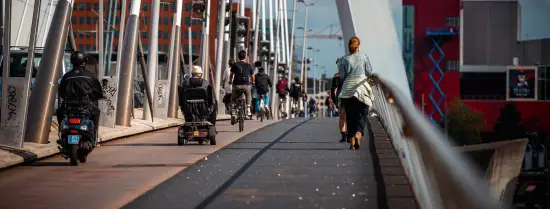
Rotterdam is becoming less and less a car city. More green spaces are being created and more and more areas are car free. Does this come at the expense of mobility in Rotterdam? Scientist Anna Bornioli addresses three misconceptions about accessibility in the city.
The municipality of Rotterdam plans to renovate Hofplein, which is currently a busy intersection. It needs to become a kind of park with much fewer cars. Many people think that these types of plans will make the city less accessible.
'When we talk about accessibility and liveability, I think we need to look at the bigger picture. 25 years ago, it was quite normal to smoke on an aeroplane. Nowadays it is not, and we are much more focused on sustainability and liveability. It's a global trend”, says Anna Bornioli, who specialises in healthy cities, urban walking and mobility behaviours.'

Are car-free cities bad for local economy?
Retailers and the hospitality industry often think that a lack of parking available very close to where they are will damage business. Car-free cities would therefore be bad for the local economy. A misconception, according to Anna. She stresses that we should not forget that Amazon and Bol.com have been big game changers in the way people experience city centres. 'Nowadays we go to the city centre for a cup of coffee and to buy a shirt. This shows that it is important to have a pleasant environment, otherwise we would not even go there.'
In addition, research at our university shows that people who went to the city centre on foot, by bike or by public transport spend more on average than people who went by car. 'This is probably because they go there more often, or because they spend the day in a nice way. In short, it is not true that car-free cities are bad for the local economy,' she emphasises.
According to Anna, there are three misconceptions about mobility in a sustainable city:
- Car-free cities are bad for the economy
- The form of the city always stays the same
- People (and their behaviour) never change
The impact of car-free cities on the local economy
People who travel to the centre on foot, by bicycle or on public transport spend more money. People who travel by car spend less money. This is the result of research carried out by Erasmus University. Bornioli explains: 'This is probably because those who travel by foot, bicycle and public transport come to the centre more often. Or because they spend the day in a nice way. In short, it is not true that car-free cities are bad for the local economy.'
Nevertheless, retailers and the hospitality industry think that a lack of parking available very close to where they are will damage business. A misconception, according to the researcher. Reasons for travelling to the city centre have changed, thanks in part to companies such as Amazon and Bol. 'Nowadays we go to the city centre for a cup of coffee and to buy a shirt. This shows that it’s important to have a pleasant environment, otherwise we would not even go there.'
Anna Bornioli talks about the role of the car in the city

We can adapt the city with car-free zones
Lots of roads and, most importantly, wide roads. In the post-war period, Rotterdam was built as a city for cars. Bornioli explains: 'Of course that’s true. But Barcelona is also a city that was built with cars in mind. And yet the municipality of Barcelona has created an innovative urban planning model in the form of so-called superblocks.'
Superblocks are areas in neighbourhoods that are totally protected from traffic. But surrounded by streets where cars can still go undisturbed and this is creating space for pedestrians, cyclists and for cars.

'With a little creativity, we can find ways to make Rotterdam a more pedestrian-friendly city'
Anna Bornioli
Urban and transport economics researcher
More car-free areas in cities also mean fewer traffic fatalities. In Barcelona, there are 700 fewer premature deaths every year. 'The bottom line is that people are walking more and there is less air pollution. It makes it clear that with a little creativity we can find ways to make Rotterdam a more pedestrian-friendly city, while maintaining accessibility,' says Bornioli.
People (and their behaviours) can change!
According to the researcher, it is not true that you cannot change people’s behaviour. 'During the pandemic, many people started working from home and are still working from home to some extent. People's habits change and it is also possible to change people’s behaviour.'
The future of mobility in Rotterdam
Bornioli is curious to see what Rotterdam’s Hofplein will look like in a few years’ time if the municipality’s redevelopment plans go ahead. 'When it comes to the accessibility and liveability of a city, I think we have to look at the bigger picture. It's only been 25 years since people were smoking on planes. Let’s see where we are in 25 years and whether we look at pictures of busy city highways with the same horror in our eyes as when we saw the picture of people smoking on planes.'
- Researcher
- More information
- Related content
